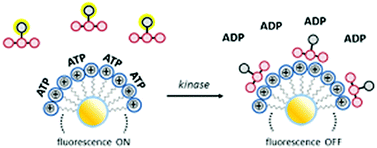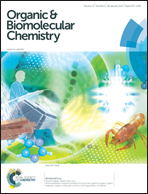Label-free fluorescence detection of kinase activity using a gold nanoparticle based indicator displacement assay
Abstract
A straightforward indicator-displacement assay (IDA) has been developed for the quantitative analysis of ATP→ADP conversion. The IDA relies on the use of gold nanoparticles passivated with a monolayer of thiols terminating with a 1,4,7-triazacyclononane (TACN)·Zn2+ head group. The analytes ATP and ADP compete to a different extent with a fluorescent probe for binding to the monolayer surface. In the presence of ATP the fluorescent probe is free in solution, whereas in the presence of ADP the fluorescent probe is captured by the nanoparticles and its fluorescence is quenched. The linear response of the fluorescence signal towards different ratios of ATP : ADP permitted the detection of protein kinase activity simply by adding aliquots of the enzyme solution to the assay solution followed by measurement of the fluorescent intensity. The assay poses no restrictions on the target kinase nor does it require labeling of the kinase substrate. The assay was tested on the protein kinases PIM-1 and Src and validated through a direct comparison with the classical radiometric assay using the [γ-32P]-labeled ATP.

- This article is part of the themed collection: Supramolecular Chemistry in Water

 Please wait while we load your content...
Please wait while we load your content...